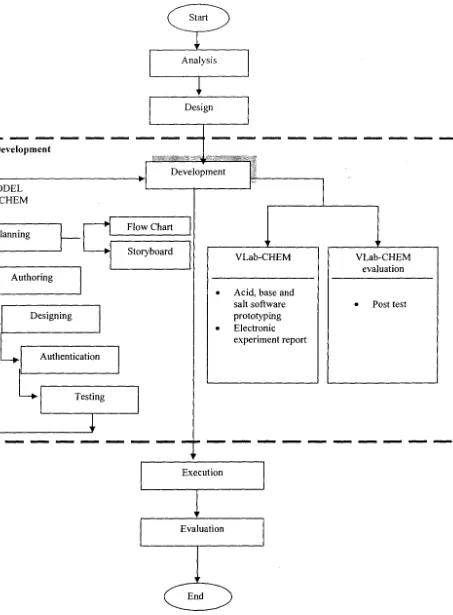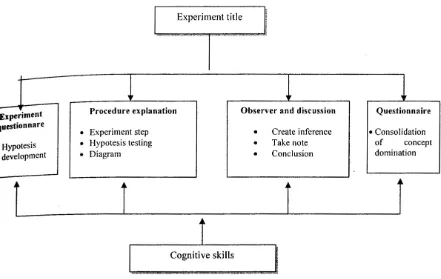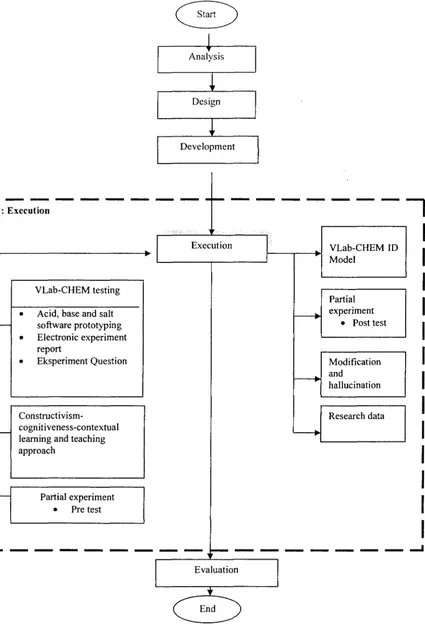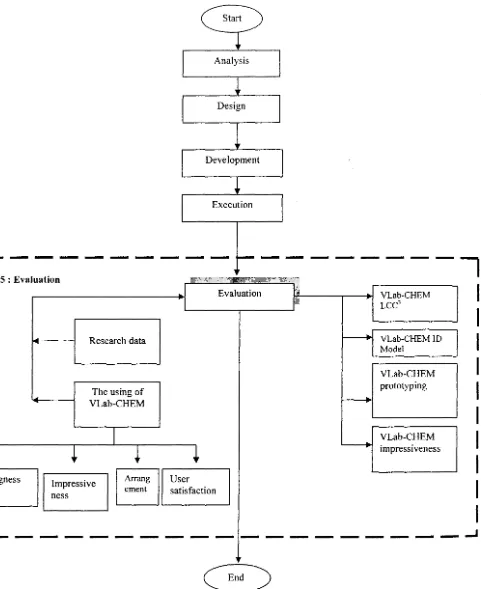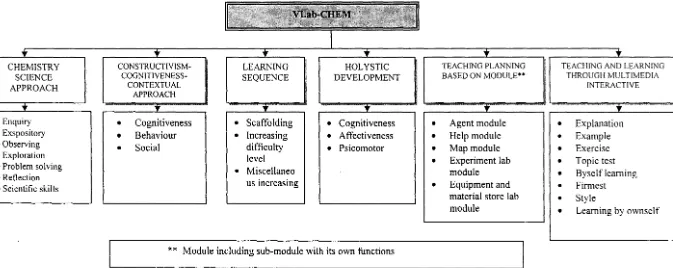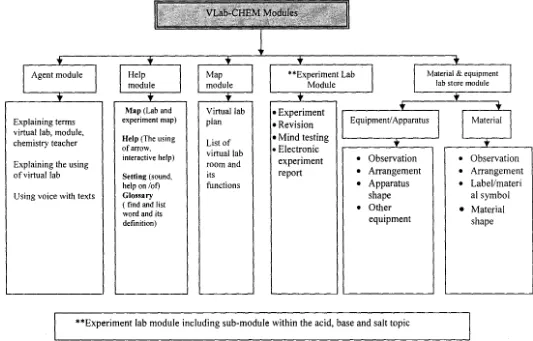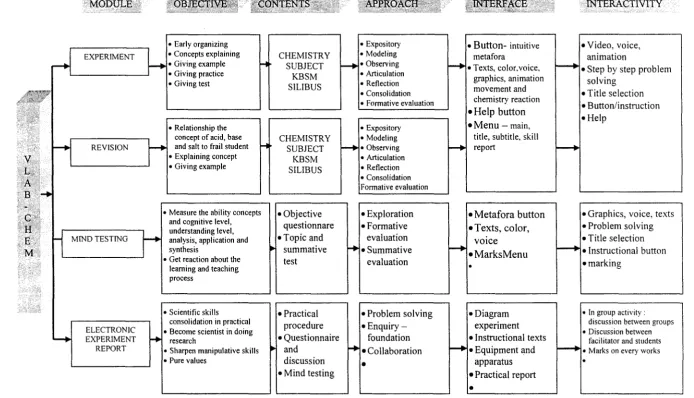THE DEVELOPMENT OF DESIGNING OF VIRTUAL LAB FOR CHEMISTRY
SUBJECT (ACID, BASE AND SALT) BASED ON
CONSTRUCTIVISM-COGNITIVENESS-CONTEXTUAL APPROACH
HAJAH NORASIKEN BAKAR
HALIMAH HJ BADIOZE ZAMAN
Paper Presented at the Seminar on Science & Its Application in Industry(SSASI 2006) Volume I
UNIVERSITI TEKNIKAL MALAYSIA MELAKA
THE DEVELOPMENT OF DESIGNING OF VIRTUAL LAB FOR
CHEMISTRY SUBJECT (ACID, BASE AND SALT) BASED ON
CONSTRUCTIVISM-COGNITIVENESS-CONTEXTUAL
APPROACH
1
Hajah Norasiken Bakar*,
2Halimah Hj Badioze Zaman
1
Jabatan Media lnteraktif, Fakulti Teknologi Maklumat Dan Komunikasi, Kolej Universiti Teknikal Kebangsaan Malaysia, K.B.1200, Ayer Keroh 75450 Melaka
Mel-e: norasiken(a1kutkm.edu.rny
2
Jabatan Sains Maklumat, Fakulti Teknologi Dan Sains Maklumat, Universiti Kebangsaan Malaysia, 43600 Bangi, Selangor Darul Ehsan
Mel-e: hbz(wftsm.ukm.mv
Abstract
This paper addresses about designing virtual laboratory for chemistry subject, acid, base and salt. Discussion involved on theoretical framework modelling where it divided into three parts that is analysis, design and, development and evaluation. For the second objective, researcher will view on constructivism-cognitive ness-contextual lifecycle model where it will be used for virtual laboratory for the chemistry subject ( VLab-CHEM ). This model will define about education media, how to measure content, authoring program and systematic instructional design. Others objective are defining Instructional Design (ID) model ( VLab-CHEM ) where it include virtual laboratory modules. ID model focused on learning and teaching aspects and science education, education process and by using multimedia interactive module. While designing the development of VLab-CHEM, researcher has used approach in learning theory such as constructivism-cognitive-contextual. Concept through learning-by-doing, contextual education, simulation, 3D animation and real time animation to create 3D virtual based on reality, will be added in the VLab-CHEM.
Keyword
Virtual lab, experiment, learning by doing, 3D
1
Introduction
The development of computer technology especially multimedia technology has been a major factor in education world. By that reason, the using of computer in learning and education has been increased. Ahmad Fauzi Mohd Ayub et al. (2005).
Research on virtual laboratory in chemistry .subject, acid, base and salt ( VLab-CHEM ) is the main research based on problem found by the student and teacher in conventional chemistry education especially in understanding on the experiment process that is not easy to prove in real world. Norasiken & Halimah ( 2005 ).
VLab-CHEM is developed as a new value in chemistry education. Besides that, VLab-CHEM that will be developed can get more attention by the student in their new way learning. Activity in the VLab-CHEM is based on interactive laboratory in order to ensure the understanding student in chemistry material process and also to do experiment. By that, VLab-CHEM will reduce cost such as time in lab, material and component used in the experiment where it differs in conventional lab.
In other way, student and teacher can do the experiment as long as they want and it will avoid the student from using the dangerous material. Norasiken and Halimah ( 2005 ).
2
Educational Theories
2.1 Constructivism Theory
Proceedings of The Seminar 011 Science & !rs Application i11 l11dust1)' (SSAS! 2006) 1 'o/ume I
Through constructivism educational theory, students have their own mind that has been created by interaction with the environment. Concepts that own by each student are differing and mistake will be occurred if the concept created opposite with the concept accepted in the classroom. Through constructivism approach in classroom, student will actively involved in educational process and they have the chance to create their own knowledge based on their background. Roziah Abdullah ( 2004 ). Jonassen ( 1994 ), constructivism members found that student should learn in order to create construct, define and make their understanding in many ways based on experience and on-line relation with environment. Education is one of activity that been done by student by their self. Shapiro ( 1994 ). By helping student in their integration with experience and new knowledge they already have, the activity should be in the context of needed requirement and in different perspective. Jonassen 1994, Oliver 2000.
2.2 Cognitiveness Theory
Cognitiveness theory refers to the process of thinking that happened to someone while in the process of learning. It relate with short time and long-time memory.
While in learning, student created a cognitive structure in their memory. Every time student learn, they will used all its experience in learning and store all the experience in their memory until they want to used it, in order to help him in the learning process.
One of the cognitive theories is information processing in learning computer. This theory offer active learning where student actively to get, restructure and define knowledge in order to make learning more fun. It is because student needs a transformation in learning and knowledge. The theory focused on new knowledge and past knowledge.
To help student in learning, software designing should be in terms of symbol and other channel so that learning more accurate and easy to get. Based on previous research, in designing learning activity, cognitive structure of student should be taken. Alessi and Trollip 2001; Simonson and Thomson 1990. Cognitive theories figures, Brunner, Piaget and Papert focused on main concept that is ( Simonson and Thomson 1990 ) :
(a) How knowledge can be arranged and structured. (b) The willingness of student to study.
(c) Give value upon intuition and intellectual approach to achieve conclusion without foJlowing analytical steps.
( d) The important of motivation to study or having positive attitude in learning.
Based on cognitive theory, some guidelines have been used in creating and evaluate learning based on computer. Simonson and Thomson 1990. The guidelines as below:
(a) The willingness to study is important to start, maintain and ensure the objective of learning. (b) Structure and types of knowledge to teach. It is based on opinion, that student start to understand
concrete operation, graphic display from reality and abstract expression and number system. ( c) The sequences of learning material are important to define the type of student in processing the
information they get. Knowledge of cognitive children style through parts of dominant brain and processing level are important to know style of learning.
(d) Type and style given depend on time and place.
(e) Leaming in terms of exploration and discovery is the important approach. LOGO language by Papert ( 1980 ) is one example learning based on computer, one way of problem solving by student.
2.3 Learning Approach Based On Contextual
Scars ( 1999 ) found that teaching and learning approach based on contextual is one concepts for helping teacher to explain content of learning in real situation and also as a motivation for student to relate the knowledge gain with real life time.
Ketter and Arnold ( 2003 ), research in case study of using teaching and learning approach based on contextual, found student can relate concept with real lifetime much better.
Hardy ( 2003 ) found student more successful in gaining knowledge and increase their performance. Approach also focused on practical approach to give student more experience using material and hands-on concept.
3
Research Purpose
The purpose of the research can be divided into two components:
(i) Developing virtual lab for chemistry subject, acid, base and salt topic for form 4 science students.
Sec/ion B: Appfied Mathema11cs and S1alist1cs
(a) Define methodology for virtual lab content for chemistry equation, acid topic, base and salt. (b) Creating Instructional Design Model ( ID Model ) for virtual reality content of chemistry
subject.
(c) Develop prototyping the content virtual lab based on constructivism-cognitive-contextual approach.
(ii) Do a research on the successfulness of vi1iual lab among chemistry student at school in Al or Gajah district, Melaka in one case study.
(a) Testing the ability of virtual lab in chemistry subject, acid, base and salt.
(b) Testing the effect of using virtual lab in the science process in the chemistry subject. (c) Test the effect of the achieving student used the virtual lab based on pre test and post test.
4
Research Objective
Result will give input to teachers and software design in the aspects; the suitable teaching for science software, technique or using software with the constructivism-cognitiveness-contextual approach in learning and teaching.
Result also will input the school execution towards the virtual lab in the readiness of teacher requirement and the willingness of student to use the knowledge based on JCT.
Baseides that, research will give a chance to Education Legislation Principle to legislate the JCT in education and give the suitable accomodation for student in upper level and also to curriculum legislation to make the virtual lab and JCT in teaching and learning in lab.
Overall, research will give the input as below:
(a) Developing a methodology of virtual lab in chemistry education.
(b) Designing an instruction model of virtual lab with constructivism-cognitiveness-contextual approach in chemistry course.
(c) Developing a virtual lab modules for constructivism-cognitiveness-contextual approach (d) Developing virtual lab prototyping
(e) Defining methodology for partial experiment to ensure the successfullness of using a virtual lab. (t) Design and produce software evaluation checklist by using the Statistical Package for the Social
Sciences (SPSS).
(g) Design questionnaire for student and teacher of chemistry course to ensure the difficult topic in chemistry subject.
(h) Produce the successfullness data of virtual lab using constructivism-cognitiveness-contextual approach.
(i) Produce the data of using virtual lab differ with conventional chemistry laboratory.
5
Theoretical Framework Model
Theoretical framework model showed the structured profile that is Analysis and Design ( I ), Development ( II ) and Evaluation ( III ) for VLab-CHEM. The development model can be seen in figures 1.1, research on theoretical framework model. It's including research questioning and research hypotesis. To achieve the purpose of research, some main question and research hypotesis is designed as below:
(a) What is the methodology used in developing virtual lab for the chemistry subject (acid, base and salt)?
(b) What is the instructional model design suitable in order to increase the cognitive skills based on virtual lab for chemistry subject (acid, base and salt)?
(c) What is the chemistry virtual lab that is suitable for instructional design?
(d) Is there any differ in terms of achieving cognitive skills between students using virtual lab with student using conventional lab?
1. Hypotesis Mol 1 (Ho I): No difference marks in pre test and post test for the experiment group in acid, base and salt topic.
ii. Hypotesis Mol 2 (Ho 2): No difference marks in pre test and post test for the control group in acid, base and salt topic.
Proceedings of The Seminar on Science & Its Application in !ndustl)' (SSAS! 2006) l'olume I
(e) Is there any difference in overall achieving between students using virtua lab for chemistry subject (acid, base and salt) with student using conventional lab?
iv. Hypotesis Mol 4 (Ho 4): No significant different between marks in pre test and post test within student in experiment group for the topic acid, base and salt.
v. Hypotesis Mol 5 (Ho 5): No significant different between marks in pre test and post test within student in control group for the topic acid, base and salt.
v1. Hypothesis Mol 6 (Ho 6): No significant difference in overall achieving between students learning through chemistry virtual lab with student learns through conventional lab.
(f) Is virtual lab for chemistry education (acid, base and salt) can improve the science skills process?
@
c:
::I:c·
Cll セN@ ct.セ@
セ@セ@
s::
D> セ@flJ ii"s::
Cll!
IANALYSIS AND DESIGN
(Virtual lab concept, P & P theory and ID model)
Virtual lab concept • Interactive
laboratory(' Agent ' -voice, text and book (glossary, map, setting,
help) Sb
• Combination 20 & 30 lab concept
• Real scenario experiment (Leaming by Doing)
• Visual animation 30 dan simulation Leaming and teaching theories : constructivism· cognitive-contextual approach
• Cognitive • Behavior • Social • Onself direction
Instructional design model
(ID):
• KBEk Roziah Abdullah
Sb
I •
DICK & CAREYj
Sa)
Theory & virtual lab design methodology of acid, base and salt • Combination ID model and
software engineering • Software development life
cycle
ID MODEL
CHEMISTRY
VIRTUAL
LAB
!
I
VIRTUAL LABI
DEVELOPMENTMODEL
II
DEVELOPMENT
(Virtual lab & development module for acid, base and salt)
•
Sd
Sc
•
Virtual lab module
• Agent
• Store (material &
apparatus)
• Help (Glossary, map, Help and equipment) • Experiment lab
(Acid, Base and salt) • Notice board
Lab map and list of lab rooms
!
Acid, base and salt software module
• Experiment
• Revision
• Testing
• Report on electronic experiment
Hol, 2, 3, 4, 5, !6
Se, Sf
Figures 1.1: Research on theoretical framework model
III EVALUATION
(Control & experiment group)
THE USING OF
VIRTUAL
CHEMISTRY LAB
( ACID, BASE AND
SALT)
• IMPRESSIVENESS
• EVALUATION ON
VIRTUAL LAB ON
THE ASPECT OF
Proceedings (Jfl71e Seminar on Science & Its Application in Jndus/1)' (SSAS/ 2006) 1 'o/ume I
6
Constructivism-Cognitivess-Contextual Model Life Cycle (LCC
3)VLab-CHEM
The development of VLab-CHEM is designed in a form of cycle to show the whole package. Adaptation from KHGK2 model, Roziah Abdullah, based on waterfall model, will give the inner and outer entity for the education needed so that there is an expanded in terms of cognitive, affective and psicomotor. 5 phases involved in the model that are: analysis, design, development, implementation and evaluation. Therefore this model is called constructivisrri-cognitiveness-contextual model life cycle.
Leaming and
Modification I teaching objective
hallucination
J
AnalysisI
Pure value セL@
I Silibus/
"" セ@
content subject
Leaming
Adding- & teaching
better
...
objectiveI
Execution,.__.
Evaluation,.__.
r Design< " · .,
ᄋセMB@ BBBBBBセ@ セ[L@ -,..,,
'"'"
··-ᄋセ@
ID Model Pre test, post
test
Observing セᄋ@ Prototyping
Development セ@
-User Leaming environment
Figures 1.2 : Constructivism-Cognitiveness-Contextual Model Life Cycle (LCC3) for VLab-CHEM
- - -
·I : AnalysisAnalysis
Section B: Applied Mathematics and Statistics
I
I
·---,
,---
---,,
I
Requirement analysis
I
I
I
I
I
I
I
: Assignment analysis :
I
:
:
,
I
I
:
l
I
: Leaming Pure value Content Evaluation :
I
--.----...,
セMMMMセセMMMセi@1er Student Content of chemistry subject KBSM
Knowledge already has
I
I
I
NNNN⦅⦅⦅MMMセL@
I
result managementI
iセMMMMセセMMMMMMGセMMMMMMMGNNNN⦅⦅⦅@
___
_,
1I
- - - _ _ _ _ _ _ _ _ _ _ _ J
I
__________ _JI
I
I
_ _ _ _ _ _ _ _ _ _ _ _ _ _ _ _ _ _ J
Design
Development
Execution
Evaluation
End
Figures 1.3 : Constructivism-Cognitiveness-Contextual Life Cycle (LCC3) for VLab-CHEM:
Proceedings of The Seminar on Science & its Application in lndust1y (SSASJ 2006) l'o/ume 1
Start
Analysis
---
- - - ,
Phase 2 : Design
•
Acid•
Base/ Alkali•
Neutralisation•
Salt and waterLearning result
Teaching and learning material content
Constraint
Pure value
Evaluation
セセセセMMMGセセセセセ@
Design
ID Model VLab-CHEM
•
Science chemistry approach•
Constructivism-cognitiveness-contextual approach
•
Learning sequence•
Planning module•
Interactive multimedia_ _ _ _ _ _ _ ..J
Development
Execution
Evaluation
End
Figures 1.4 : Constructivism-Cognitiveness-Contextual Life Cycle (LCC3) for VLab-CHEM:
Design phase
---
: DevelopmentMODEL ab-CHEM
MpMi。⦅ョョ⦅ゥョ⦅ァMMセセ@
Authoring
Designing
Authentication
Flow Chart
Storyboard
t
AN⦅⦅⦅セt・ウエゥョァ⦅⦅⦅⦅N@
i
Sec/1011 B: Applied Mathematics and Stat1s/1cs
Start
Analysis
Design
---.
VLab-CHEM
• Acid, base and salt software prototyping • Electronic
experiment report
Execution
Evaluation
End
VLab-CHEM evaluation
• Post test
Figures 1.5 : Constructivism-Cognitiveness-Contextual Life Cycle (LCC3) for VLab-CHEM:
[image:10.613.10.463.41.656.2]セ M . JThe Seminar on Science & lts Application in lndust1 y (SSAS/ 2006) / "o/ume I
セ ᄋ イイッ」・・、ュァウ@ o;
Experiment title
-l
I
l
-Experiment Procedure explanation Observer and discussion Questionnaire questionnare
•
Experiment step•
Create inference • Consolidation Hypotesis • Hypotesis testing•
Take note of concept•
development • Diagram•
Conclusion domination
-t
I
I
J
Cognitive skills
Figures 1.6 : The design of electronic experiment report
8284
[image:11.600.11.452.46.325.2]Section 8. Applied Mathematics and Statistics
Analysis
Design
Development
e 4 : Execution
---
---,
-VLab-CHEM testing
• Acid, base and salt software prototyping • Electronic experiment
report
• Eksperiment Question
Constructivism-cognitiveness-contextual learning and teaching approach
Partial experiment • Pre test
-Execution
Evaluation
End
VLab-CHEM ID Model
Partial experiment
• Post test
Modification and
hallucination
Research data
______
_..
Figures I. 7 : Constructivism-Cognitiveness-Contextual Life Cycle (LCC3) for VLab-CHEM:
[image:12.598.12.437.37.661.2]Proceedings of The Seminar 011 Science & Its Applicatio11 i11 !11dusl1J· (SSAS! 2006) f'olume I
Start
Analysis
Design
Development
Execution
IS e 5 : Evaluation
.I
EvaluationI
セ@VLab-CHEM
I
I rLCC3
.
VLab-CHEM ID
セ@
Research data
セ@
Model
VLab-CHEM
The using of prototyping
セ@ セ@
-
VLab-CHEMI
.
VLab-CHEMi
i
i
i
rimpressiveness
s
ngness Impressive User
satisfaction
ness t
- - - -
---1r
Figures 1.8 : Constructivism-Cognitiveness-Contextual Life Cycle (LCC3) for VLab-CHEM:
Evaluation phase
B286
I
I
I
I
I
I
I
I
I
I
I
[image:13.603.13.494.49.638.2]Section B: Applied Mathematics and Stat1st1cs
7
VLab-CHEM Model Instructional Design
ID model for the development of YLab-CHEM in educational for the chemistry subject Form 4 is based on technology integration. The core of teaching and learning process based on teaching theory and pedagogy.
The purposes of the model are to increase the knowledge of acid, base and salt, high level thinking skills and scientific skills within the student of the chemistry science.
The development of the model based on educational environment such as: (a) Leaming result.
(b) Pure value.
(c) Scientific skills and high level thinking skills. (d) Teaching material based on achieving level. (e) Holystic development.
CHEMISTRY
I I
CONSTRUCTIVISM- LEARNING HOLYSTIC TEACHING PLANNING
'
TEACHING AND LEARNINGSCIENCE COGNITIVENESS- SEQUENCE DEVELOPMENT BASED ON MODULE** THROUGH MULTIMEDIA
APPROACH CONTEXTUAL INTERACTIVE
APPROACH
i
...
...
••
•Enquiry
•
Cognitiveness•
Scaffolding • Cognitiveness•
Agent module•
Explanation • Exspository•
Behaviour•
Increasing • Affectiveness•
Help module•
Example •Observing•
Social difficulty • Psicomotor•
Map module•
Exercise • Exploration level•
Experiment lab•
Topic test • Problem solving•
Miscellaneomodule Byself learning
• Reflection
•
• Scientific skills us increasing
•
Equipment and•
Firmest material store lab•
Stylemodule
•
Leaming by ownself**
Module including sub-module with its own functionsFigures 1.9: VLab-CHEM ID Model Development
8288
[image:15.849.157.830.48.316.2]Agent module
Explaining terms virtual lab, module, chemistry teacher
Explaining the using of virtual lab
Using voice with texts
Map (Lab and experiment map)
Help (The using of arrow, interactive help)
Setting (sound, help on /of) Glossary ( find and list word and its definition)
Virtual lab
I
plan 1 • •Revision Experiment
List of •Mind testing virtual lab • Electronic
room and experiment
its report
functions
Material & equipment lab store module
I I
Equipment/ Apparatus I I Material•
Observation•
Observation•
Arrangement•
Arrangement•
Apparatus•
Label/materishape al symbol
•
Other • Materialequipment shape
**Experiment lab module including sub-module within the acid, base and salt topic
Figures I. I 0 : VLab-CHEM modules
[image:16.855.241.774.31.372.2]1
•
H
'--+
Pセ Q セZZZPゥセZセGZセ@ セ[@ イ|セ PW@'MODULE>
EXPERIMENT REVISION• Early organizing
セ@
• Concepts explaining• Giving example -t
• Giving practice • Giving test
• Relationship the concept of acid, base
r
and salt to frail student H• Explaining concept • Giving example
• Measure the ability concepts and cognitive level,
r
understanding level, MIND TESTING analysis, application andsynthesis
• Get reaction about the learning and teaching process
• Scientific skills consolidation in practical ELECTRONIC • Become scientist in doing EXPERIMENT
I-+
researchREPORT • Sharpen manipulative skills • Pure values
CHEMISTRY SUBJECT KBSM SILIBUS CHEMISTRY SUBJECT KBSM SILIBUS •Objective questionnare •Topic and セ@ summative test •Practical procedure • Questionnaire セ@ and discussion •Mind testing
• Expository • Button- intuitive
•Modeling metafora
_...
•Observing セ@ •Texts, color, voice, • Articulationgraphics, animation •Reflection
movement and • Consolidation
• Formative evaluation chemistry reaction •Help button
• Expository •Menu - main,
•Modeling title, subtitle, skill
f-+ •Observing
_...
report• Articulation • Reflection • Consolidation Formative evaluation
•Exploration • Metafora button
•Formative •Texts, color,
evaluation voice
i-. •Summative I-+
•MarksMenu
evaluation
•
•Problem solving •Diagram
•Enquiry- experiment
foundation • Instructional texts
I-+
•Collaboration H •Equipment and•
apparatus•Practical report
•
Figures 1.11 : Modules inside VLab-CHEM Experiment Lab
B290
INTERACTIVITY
•Video, voice, animation
--+
•Step by step problemsolving •Title selection •Button/instruction •Help
1---+
•Graphics, voice, texts •Problem solving •Title selection
セ@ •Instructional button
•marking
• In group activity : discussion between groups • Discussion between
1---+ • Marks on every works facilitator and students
[image:17.844.103.797.9.406.2]Section B: Applied Mathematics and Statistics
Conclusion
This paperwork has been discussing the research methodology including VLab-CHEM development methodology. Detail description through phases involved in the development. Through virtual lab methodology, constructivism-cognitiveness-contextual life cycle for chemistry subject has been produced. In the VLab-CHEM, one instructional model has been developed with the constructivism-cognitiveness-contextual approach where model focused on science approach, learning sequence, holystic development, planning learning, and teaching and learning through interactive multimedia.
References:
[I] Ahmad Fauzi, Norhayati & Tengku Muhammad. (2005). Pembangunan Perisian Kursus Tutorial Multimedia Matematik Kalkulus Menggunakan Pendekatan Pembelajaran Masteri. Konvensyen Teknologi Pendidikan Ke-18. Inovasi Teknologi Instruksional Dalam Pengajaran Dan Pembelajaran : 179-184.
[2] Alessi S.M. & Trollip, R. (2001). Computer Based Instruction : Methods and Development. Ed. Ke-3. New Jersey: Prentice Hall.
[3] Hajah Norasiken Bakar & Halimah Badioze Zaman. (2005). Analisis Awai Makmal Maya Bagi Pengajaran Kimia (Asid, Base dan Garam). Konvensyen Teknologi Pendidikan Ke-18. Inovasi Teknologi Instruksional Dalam Pengajaran Dan Pembelajaran : 809-816
[4] Hardy, T. C. (2003). Contextual Teaching In Science. Citing Internet sources URL http:/iwww.kennesaw.edu/english/ContextuaJLearning/2003/Bartow/TeraHardy.pdf.
[5] Jonassen, D.H. (1994). Thingking Technology. Educational Technology 34 (4):34-37.
Ketter, C. T., & Arnold, J. (2003). Implementing Contextual Teaching and Learning: Case Study Of Nancy, A High School Science Novice Teacher. Internet sources URL http://www. coe. uga. ed u/ctl/ casestud y ! A mo Id. pdf.
[6] Mohd. Arif Ismail, Abdullah Mohd. Sarif, Rosnaini Mahmud. (2000). Pembangunan Perisian Multimedia Interaktif Geografi. Prosiding Konvensyen Teknologi Pendidikan Ke-13. Persatuan Teknologi Pendidikan Malaysia. Diedit Oleh Yusup Hashim & Razmah Man.
[7] Oliver, K. M. (200). Methods for Developing Construktivist Learning On The Web. Educational Technology 40 ( 6) : 5-18.
[8] Papert, S. 1980. Mindstorms: Children, Computer and Powerful Ideas. New York: Basic Books [9] Roziah Binti Abdullah. (2004). Pembangunan Dan Keberkesanan Pake} Multimedia Kemahiran
Berjikir Bagi Mata Pelajaran Kimia. Ph.D.diss., Universiti Kebangsaan Malaysia.
[IO] Sears, S. J. (1999). What Is Contextual Teaching And Learning? Internet sources URL http://www.contextual.org/.
[11] Shapiro, B. (1994). What Children Bring To Light: A Constructivist Perspective On Children Learning In Science. Teachers College Press: New York.
